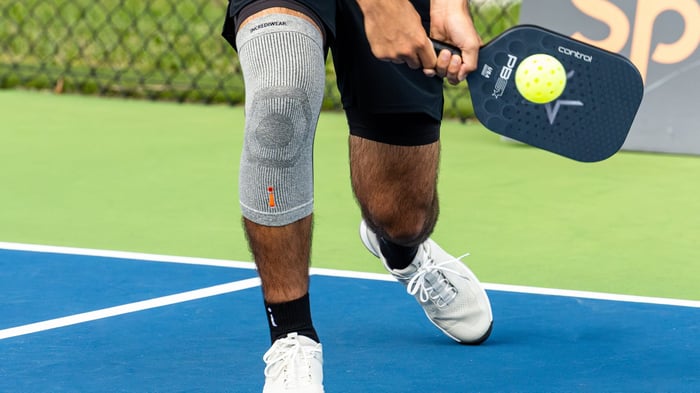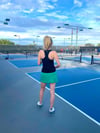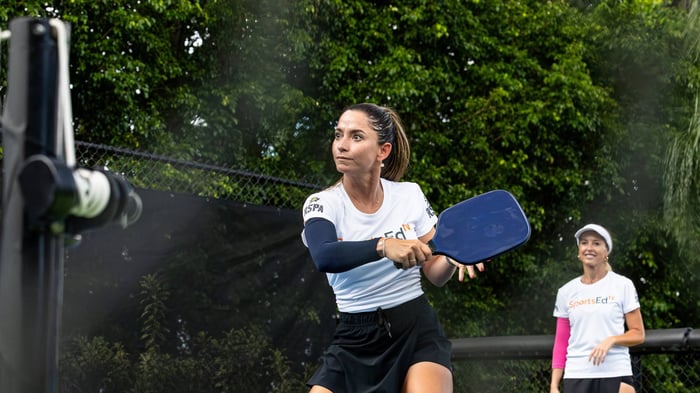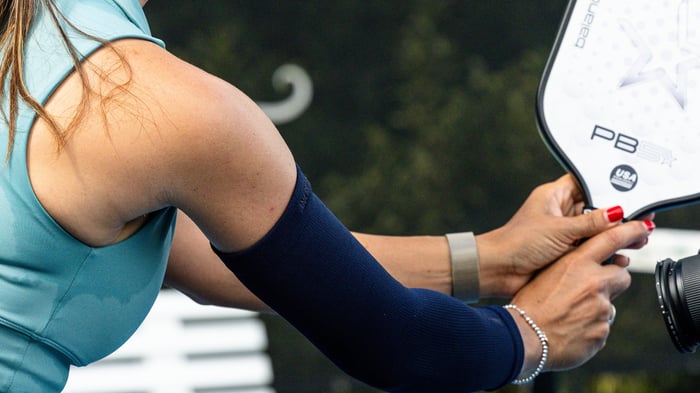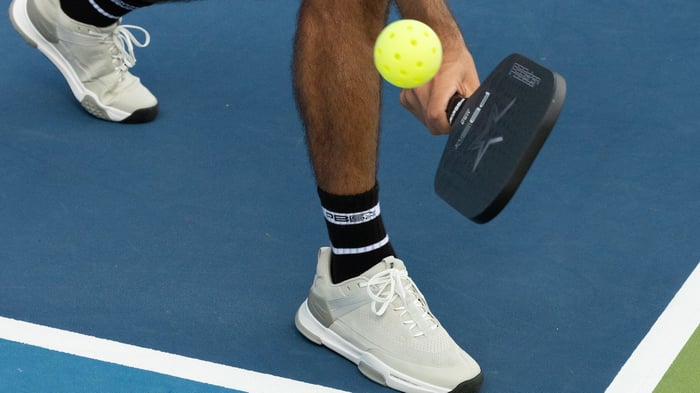Key takeaways:
Mastering pickleball's fundamental serves, volleys, and dinks is essential for improving your gameplay and increasing your confidence on the court.
Understanding when and how to use different shots, such as serves, dinks, volleys, and drives, can significantly impact your performance and help you outmaneuver your opponents.
Effective practice drills for serving, dinking, and volleying can build muscle memory, improve coordination, and enhance your overall pickleball skills.
Pickleball is easy to learn but packed with depth, a blend of strategy, precision, and quick thinking. Whether you're serving, dinking, or volleying at the net, every shot you make can shape the outcome of the rally. For beginners, learning the basic shots isn't just helpful; it’s essential to building confidence, improving control, and enjoying the game at any level.
From technique tips and beginner-friendly drills to common pitfalls and FAQs, this guide gives you everything you need to start strong. At PB5star, the right gear and apparel can make a big difference. We offer court-tested paddles, stylish apparel, and beginner-friendly accessories to elevate your pickleball experience.
Understanding the basics of pickleball technique
Before diving into specific shot types, it’s essential to understand what makes pickleball unique from other paddle or racquet sports. While it shares elements with tennis, ping-pong, and badminton, pickleball is defined by its fast pace at the net, strategic control over power, and the importance of placement over sheer force.
The foundation of every successful player lies in hitting the ball and mastering when, where, and how to place it. Learning the basic shots is the first step to becoming a smart, confident player who can control rallies, force errors, and set up winning plays.
Types of pickleball shots
Pickleball might seem simple at first glance, but mastering the game involves learning various shots, each with its own purpose, technique, and strategy. Whether you're serving, defending, or dominating at the net, knowing which shot to use and when can make all the difference.
Serve: The shot that starts each point. It must be hit underhand, diagonally crosscourt, and land beyond the kitchen (non-volley zone).
Dink shot: A soft shot that arcs over the net and lands in the kitchen. It slows down the pace and forces your opponent to hit up.
Volley: A shot taken out of the air before it bounces, often executed at the net, used to keep pressure on opponents.
Each shot in pickleball serves a strategic role, and learning when to use them is just as important as how to hit them. As a beginner, focus on control and consistency with key shots like the serve, dink, and volley. Mastering a variety of shots strengthens your overall game and makes you a more unpredictable and effective opponent on the court.
How to master pickleball serve
The serve is where every point in pickleball begins, and it can set the tone for the entire rally. A well-executed serve puts your opponent on the defensive, helps you control the pace, and limits their shot choices right from the start. For beginners, developing a consistent and legal service is one of the most important skills to build early on.
How to serve in pickleball
Before improving your serve, you must understand what a legal and practical serve looks like. From your grip and stance to contact and follow-through, every detail matters. This subsection walks you through the mechanics of a proper serve and introduces a few basic styles to try as you grow your confidence.
Grip and stance: Use a continental or eastern grip, stand behind the baseline, and square your shoulders toward the opposite service box.
Paddle position: The paddle head must be below the wrist at contact. Avoid any upward flicks that lift the paddle head above this point.
Feet position: When contacting the ball, at least one foot must remain behind the baseline, and there must be no foot faults!
Serve placement: Aim diagonally across the court, keeping the ball deep and low to limit your opponent’s offensive options.
Underhand motion: The ball must be struck with an underhand swing, and contact must be made below the waist.
Serving drills for beginners
The only way to develop a consistent serve is through repetition, but repetition with purpose. These beginner-friendly drills help you practice effectively, challenge your precision, and turn your serve into a real asset during gameplay.
Target cone drill: Set up cones or markers in the back corners of the diagonal service box. Aim to land your services as close as possible to these zones.
Power vs. control drill: Alternate between fast power serves, and soft lob serves to develop control over strength and touch.
Wall serve drill (if solo): Practice your swing motion and contact point before a wall or mirror. Focus on mechanics and body alignment.
Developing a confident, repeatable serve sets you up for stronger rallies and easier points. Don't worry about power at first; consistency, legality, and placement will take you much farther in the early stages of your pickleball journey.
Dinking like a pro
While powerful serves and flashy smashes can feel exciting, the dink shot, a soft, controlled shot that barely clears the net, determines who wins or loses in pickleball. A dink is a smooth, low shot hit near the non-volley zone (the "kitchen") that arcs just over the net and lands inside your opponent’s kitchen. It’s not designed to win the point outright but to set up your next move by keeping the ball low and unattacked.
How to execute a dink shot
Dinking isn’t about strength but touch, timing, and control. Whether trying to extend a rally or set up an attacking opportunity, a well-executed dink forces your opponent to play a low ball, limiting their options. Mastering this shot starts with proper form and technique.
Grip: Use a relaxed, continental grip. Tension in your hand can lead to erratic ball control.
Body position: Stay low, with knees bent, and paddle out in front of your body.
Paddle angle: Keep the paddle slightly open and swing gently, upwardly.
Contact point: Let the ball drop to knee level or below and strike it in front of your body.
Footwork: Position yourself before the shot. Reach with your feet, not your arm.
Dinking drills for beginners
The best way to improve your dink shot is through repetition, not just repetition. Practicing with focus and intention helps you build touch, improve placement, and feel more comfortable near the net. These beginner-friendly drills are easy to set up and great for developing consistency and accuracy.
Crosscourt dink practice: Crosscourt dinks give you more space to work with and are harder to attack. Rally cross-court with a partner to build consistency from this angle.
Solo wall dinks: Stand close and aim to softly dink the ball just above a chalk line or tape mark on the wall to work on touch and control.
Straight-on dink rally: Stand across from a partner at the kitchen line and rally dinks straight ahead, focusing on consistency and low net clearance.
The dink shot may not be flashy, but it's one of your pickleball game's most strategic and important tools. Mastering the dink gives you control over the tempo, frustrates aggressive opponents, and creates openings to finish points.
Volleying drills
Volleying is all about quick hands, sharp reflexes, and precise paddle control, especially at the kitchen line, where rallies are won or lost in a split second. Unlike groundstrokes, volleys are taken out of the air before the ball bounces, giving your opponent less time to react. To get comfortable with volleys, you must train your reaction speed, hand-eye coordination, and control under pressure.
How to execute a volley
Volleying well starts with solid fundamentals. While it may look simple, the volley is a finesse move requiring control, readiness, and efficiency. In this subsection, you’ll learn what proper volley form looks like and how to stay consistent under pressure. To execute a clean and effective volley:
Ready position: Keep your paddle centered at chest height and slightly in front of your body.
Contact point: Hit the ball before your body, keeping the swing compact. Avoid big follow-throughs.
Placement over power: Aim for control. Place the ball low and away from your opponent, ideally to their backhand or at their feet.
Volleying drills for beginners
Practicing volleys regularly is the best way to develop muscle memory and reflexes that hold up during competitive play. These drills are designed to improve your paddle control, reaction speed, and shot placement, all while keeping things simple and fun.
Wall volley reps: Stand a few feet from a wall and hit repeated volleys straight into it. Keep the paddle up, swing shot, and maintain a rhythm.
Partner kitchen rally: Both players stand at their kitchen lines and volley back and forth. Start slow, then increase speed as control improves.
Target volley practice: Set up cones or small targets in different spots in your opponent’s kitchen area. During rallies or dinks, aim volleys toward specific zones.
Volleying might initially feel fast and intimidating, but with the right technique and consistent practice, it quickly becomes one of the most satisfying parts of your game. These drills are simple, repeatable, and perfect for players who want to feel confident during fast-paced net exchanges.
Frequently asked questions (FAQ) about pickleball shots
Whether you’re just starting or refining your fundamentals, it’s natural to have questions as you learn new skills. This section covers some of the most common concerns beginners face when learning pickleball shots, from technique and timing to practice habits and strategy. Use these quick answers as a guide to stay on track and continue building confidence on the court.
Why is the dink shot so important in pickleball?
The dink is a strategic shot that keeps the ball low and hard to attack, especially near the non-volley zone. It helps neutralize power players, slows down fast-paced rallies, and creates opportunities to force mistakes or set up a winning shot. A good dink game gives you control over tempo and forces your opponent to play on your terms.
What pickleball shots should I learn first as a beginner?
Start with the basics: the serve, return of serve, and dink shot. These form the foundation of your game. Once you’re comfortable with consistency and control, you can move on to volleys, drop shots, and more advanced plays like lobs and smashes. Focus on mastering one or two shots simultaneously rather than learning everything.
How do I improve my consistency in pickleball?
Consistency comes from good technique, regular practice, and smart shot selection. Start with slow-paced drills that emphasize control, not power. Use repetition-based exercises like wall drills or rally drills with a partner. Over time, consistency improves naturally as you build muscle memory and timing.
Mastering the basics: Your path to pickleball success
Mastering pickleball doesn’t happen overnight, but building a strong foundation with the basic shots will take you farther than any shortcut. From consistent serves to controlled dinks and confident volleys, each shot plays a strategic role in helping you win more points and enjoy the game more deeply. The more you practice purposefully and understand what each shot is meant to do, the more your skills, confidence, and court presence will grow.
Whether you're drilling solo or rallying with friends, remember that success in pickleball comes from brilliant shot selection, steady improvement, and showing up with the right mindset and gear. At PB5star, we’ve covered you with reliable paddles, performance apparel, and must-have accessories to keep you looking sharp and playing your best.



